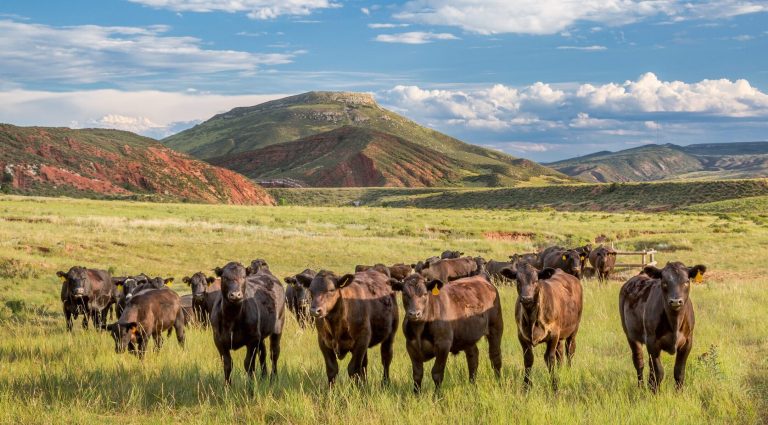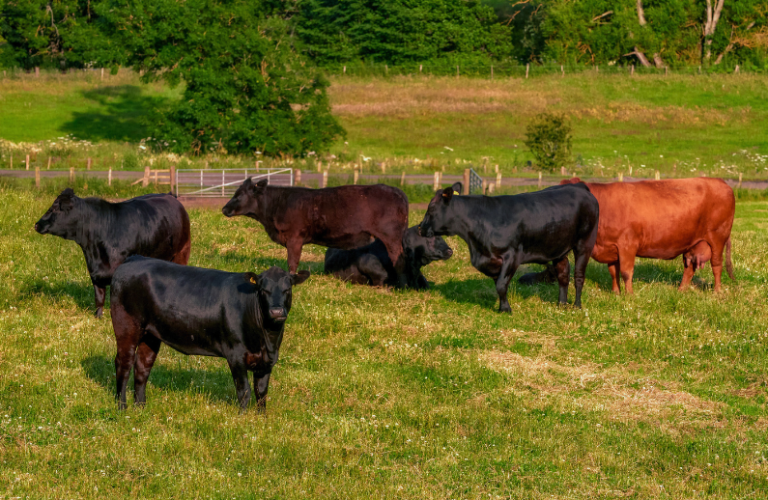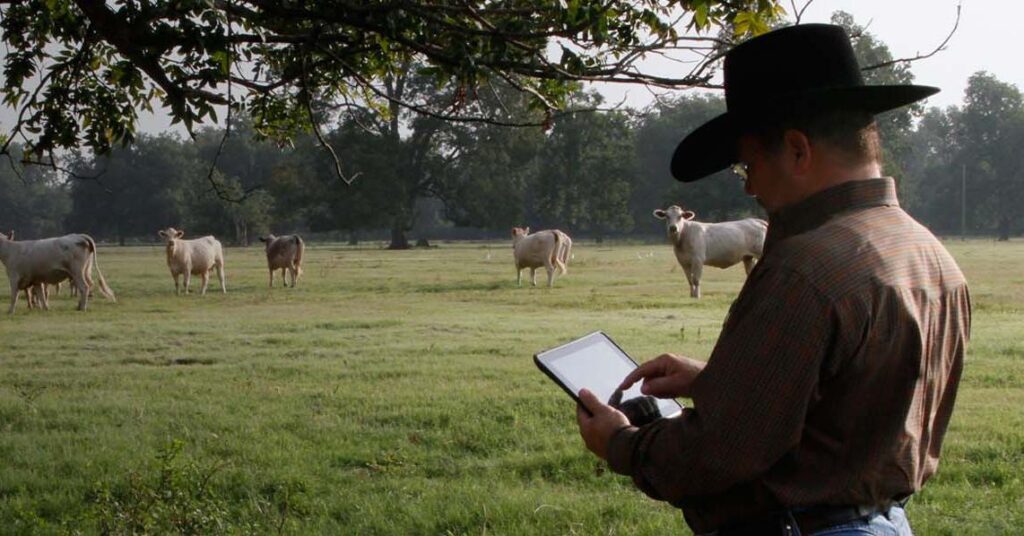Cow-Calf Stocking Rate
What it is, how to calculate it, and how it can boost decision-making
As a producer, you want to run the most efficient and profitable cattle operation possible.
Knowing your cow-calf stocking rate is a key step toward smarter decisions, stronger land management, and improved profitability. It helps you match your herd size to your land’s capacity, ensuring you are grazing efficiently and sustainably.

What is a cattle stocking rate?
A stocking rate is the number of animals grazing on a given area of land over a set period of time. In other words, how many cows can your land support based on its carrying capacity?
Since cattle vary in size and forage needs, producers use Animal Units (AUs) or Animal Unit Equivalents (AUEs) to standardize stocking rate calculations.
- Animal Unit (AU): A standard measure based on a 1,000-pound cow, with or without a nursing calf, consuming about 26 pounds of dry forage per day.
- Animal Unit Equivalent (AUE): A conversion factor used to adjust for animals of different sizes, ages, or forage needs, such as bulls, yearlings, or weaned calves.
To calculate an AUE, use this formula:
AUE = Animal Weight (lbs) ÷ 1,000
Example AUE Calculations:
1,200 lb cow:
AUE = 1,200 ÷ 1,000 = 1.2
600 lb calf:
AUE = 700 ÷ 1,000 = 0.7
Cow-calf pair (1,100 lb cow and 300 lb calf):
AUE = (1,100 + 300) ÷ 1,000 = 1.4
Dry cows:
1,200 ÷ 1,000 = 1.2 AUE
15 × 1.2 = 18 AUE
Weaned calves:
600 ÷ 1,000 = 0.6 AUE
10 × 0.6 = 6 AUE
Total AUEs = 18 + 6 = 24 AUE
How to calculate total AUEs
To calculate your total AUEs, multiply the AUE of each class of animal by the number of animals in that group. Then, add all the results together to get your total AUEs for the herd.
For example, you have 15 dry cows weighing 1,200 lbs and 10 weaned calves weighing 600 lbs.
Once you’ve determined your total AUEs, you’re ready to calculate your stocking rate.
How do you calculate your herd’s stocking rate?
To calculate the cattle stocking rate, multiply the total Animal Unit Equivalents by the length of the grazing season, then divide by your total land area.
Total Land Area ÷ (Total AUE × Grazing Season Length)
For example, if you have 500 acres with 100 Animal Unit Equivalents and a 12-month grazing season, your stocking rate calculation would be:
500 acres ÷ (100 AUEs x 12 months) = 0.42 acres per AUE per month
This value is the number of acres needed to support one animal unit equivalent each month. This also helps you determine if your stocking level aligns with your land’s carrying capacity.

Why is it important to know the stocking rate?
When you calculate a stocking rate, you can make informed business decisions for your operation.
Your stocking rate helps you estimate production costs, such as how much forage your herd will need each day or month, and what you can expect to spend on inputs based on the number of Animal Unit Equivalents.
Operating with an optimal stocking rate helps improve efficiency, reduce costs, and improve animal performance. If the stocking rate is too high for the land’s carrying capacity, your cattle may not get the forage they need to maximize productivity. You could also overspend on input costs or risk damaging the long-term health and usability of your land.
On the other hand, if your stocking rate is too low, you may not be getting the most out of your land.
All of these challenges can impact your farm’s bottom line. Historical data shows a clear link between stocking rate and profitability. For example, higher stocking rates are often found in areas with better forage-growing conditions.
Does climate impact stocking rates?
Shifts in temperature and rainfall patterns, especially in major cattle-grazing regions of the United States, significantly impact forage growth and availability, which in turn affects stocking rates.
For instance, stocking rates have been shown to decrease when the temperature-humidity index rises during summer in the U.S.
Strategies to improve your stocking rate
A few strategies can help boost your stocking rate and maximize the use of the land. For example, some ranchers rotate their cattle throughout different pastures. This can extend the grazing season and optimize pasture utilization.
Ranchers can also introduce different types of forage species to improve pasture quality. Alfalfa, for instance, offers more protein per acre than other forage types. When mixed with other grass species, it can increase the overall nutritional value available to your cattle, helping improve your stocking rate.

Organize your operational records, optimize decision-making
Your stocking rate is only as useful as the records behind it. Without accurate and organized cattle records, it’s hard to know where you stand, whether you’re looking at stocking rates, grazing plans, or herd performance.
CattleMax cattle software keeps everything in one place, so you can spend less time tracking things down and more time focusing on your herd.
To keep better track of your records and make confident decisions for your operation, try a free 21-day trial or schedule a personalized demo.

Jacqueline
Jacqueline, a true Wyoming native, was raised on her family's ranch just north of Cheyenne. Her journey led her to the University of Wyoming, where she earned a Bachelor of Business Administration in Management and Marketing. She and her husband, Darrell, manage a thriving herd of commercial Angus cattle.

